1. Integrated Air Defence Weapon System (IADWS): India’s Maiden Test of Indigenous System – Defence & Security

Why in News?
The Defence Research and Development Organisation (DRDO) has successfully conducted the maiden flight test of the Integrated Air Defence Weapon System (IADWS) off the coast of Odisha. This marks a significant step in India’s quest for self-reliance in advanced defence technology, in line with the Atmanirbhar Bharat initiative.
Key Features of IADWS
Three-Layered Defence Structure
- Quick Reaction Surface-to-Air Missile (QR-SAM):
- Range: Up to 30 km.
- Capable of engaging multiple aerial targets rapidly.
- Very Short Range Air Defence System (VSHORADS):
- Range: Up to 6 km.
- Effective against low-flying threats like UAVs and helicopters.
- Directed Energy Weapon (DEW):
- High-power laser-based weapon.
- Range: 2–4 km.
- Disables aerial targets using energy beams (non-kinetic).
Advanced Command & Control
- Operated through a Centralised Command and Control Centre.
- Developed by the Defence Research and Development Laboratory (DRDL).
- Ensures real-time threat assessment and response.
Technological Integration & Development
- Incorporates technologies developed over time by multiple DRDO labs.
- Traces its roots to the Integrated Guided Missile Development Programme (IGMDP) initiated by Dr. A.P.J. Abdul Kalam in 1983.
Public-Private Synergy
- Carborundum Universal Limited (CUMI) has been licensed by DRDO to manufacture critical ceramic radomes, reflecting tech transfer to private players.
- Enhances defence indigenisation and creates industrial growth opportunities.
Global Learning & Strategic Collaboration
- Draws inspiration from Israel’s air defence architecture like:
- Iron Dome (short-range).
- David’s Sling (medium to long-range).
- Helps India in developing an indigenous, multi-layered air defence system.
Significance for India
- Reduces dependence on imported systems.
- Improves strategic deterrence and aerial threat neutralisation capability.
- Supports Make in India and strengthens national security infrastructure.
- Encourages public-private R&D collaboration in defence manufacturing.
Exam Connect – Possible Questions
Prelims
1. With reference to the Integrated Air Defence Weapon System (IADWS), consider the following statements:
1. It consists of only two layers of defence – VSHORADS and QR-SAM.
2. It uses Directed Energy Weapons (DEWs) as one of its components.
3. The command and control centre for IADWS is developed by Bharat Electronics Limited.
Which of the statements given above is/are correct?
A. 1 and 2 only
B. 2 only
C.1 and 3 only
D.1, 2 and 3
Answer: B. 2 only
Statement 1 is incorrect (three-layered, not two).
Statement 3 is incorrect (developed by DRDL, not BEL).
2. The term “Directed Energy Weapons” recently seen in the news is best described as:
A. Satellite-based surveillance systems
B. Chemical explosives used in landmines
C. Weapons that use energy beams like lasers to disable targets
D.Cyber tools used to disrupt command networks
Answer: C. Weapons that use energy beams like lasers to disable targets
Mains
1. “India’s successful test of the Integrated Air Defence Weapon System (IADWS) marks a major step toward indigenous defence capability.” Critically analyse the role of indigenous multi-layered air defence in strengthening India’s national security.
2. Discuss the significance of public-private partnerships and global learning in advancing India’s indigenous defence technologies, with special reference to IADWS.
2. Rivers, Dams, and Headworks of Punjab – Geography

Why in News?
Recent flooding in Punjab has been triggered by:
- Heavy rainfall in Himachal Pradesh
- High water discharge from major dams:
- Bhakra Dam
- Pong Dam
- Ranjit Sagar Dam
- Controlled water releases from various headworks in Punjab
These events have underscored the importance of river management infrastructure in Punjab.
Key Rivers in Punjab
1. Sutlej River
- Origin: Rakshastal Lake, Tibet
- Enters India: Shipki La, Himachal Pradesh
- Enters Punjab: Near Rupnagar
- Merges: With Beas at Harike, and later with Chenab in Pakistan
- Major river for irrigation and hydropower
2. Beas River
- Origin: Beas Kund near Rohtang Pass, Himachal Pradesh
- Regulated by Pong Dam
- Joins Sutlej at Harike
3. Ravi River
- Origin: Bara Banghal, near Rohtang Pass
- Enters Punjab near Pathankot, flows through Gurdaspur
- Enters Pakistan and merges with Chenab
- Flows regulated by Ranjit Sagar Dam
Major Dams in Punjab and Neighbouring Regions
Bhakra Dam
- Located near Nangal (HP-Punjab border)
- Built on the Sutlej River
- One of India’s highest gravity dams
- Creates Gobind Sagar Lake
- Functions:
- Irrigation
- Hydropower
- Flood control
Pong Dam (Maharana Pratap Sagar)
- Located in Kangra, Himachal Pradesh
- Built on Beas River
- Regulates Beas water flow to Punjab and Rajasthan
- Important for irrigation and power generation
Ranjit Sagar Dam
- Also called Thein Dam
- Located on the Ravi River, on Punjab–Jammu & Kashmir border
- Supplies water to Upper Bari Doab Canal (UBDC)
- Supports irrigation and hydropower
Key Headworks in Punjab
1. Ropar Headworks
- Located on the Sutlej River
- Feeds:
- Sirhind Canal (Punjab)
- Bhakra Main Line (BML) Canal (Punjab & Haryana)
2. Hussainiwala Headworks
- Located near Firozpur
- Distributes water via:
- Bikaner Canal
- Eastern Canal
(Serves parts of Punjab and Rajasthan)
3. Madhopur Headworks
- Located on the Ravi River
- Feeds the Upper Bari Doab Canal (UBDC)
- Supplies water to Punjab and parts of J&K
Impact of Climate Events
- Heavy upstream rainfall (Himachal Pradesh) and dam discharges have increased flood risks in Punjab’s low-lying villages
- Highlights need for:
- Better disaster preparedness
- Timely water release coordination
- Strengthening embankments and drainage systems
Exam Connect – Possible Questions
Prelims
1. Which of the following pairs is correctly matched?
| River | Headwork |
|---|---|
| A. Ravi | Hussainiwala |
| B. Beas | Madhopur |
| C. Sutlej | Ropar |
| D. Ravi | Bhakra |
Answer: C. Sutlej – Ropar
2. Consider the following statements about Bhakra Dam:
1. It is built on the Beas River.
2. It forms the Gobind Sagar Lake.
3. It is one of the tallest gravity dams in India.
Which of the statements is/are correct?
A. 1 and 2 only
B. 2 and 3 only
C. 1 and 3 only
D. 1, 2 and 3
Answer: B. 2 and 3 only
Statement 1 is incorrect (Bhakra Dam is on Sutlej, not Beas)
Mains
1. Discuss the strategic importance of the river dam and headwork infrastructure in Punjab. How do these structures help in water management and flood control in the region?
2. Explain the inter-state implications of dam discharges and headwork releases from Himachal Pradesh to Punjab, especially in the context of increasing extreme weather events.
3. Pong Dam: Hydrological and Ecological Significance – Environment
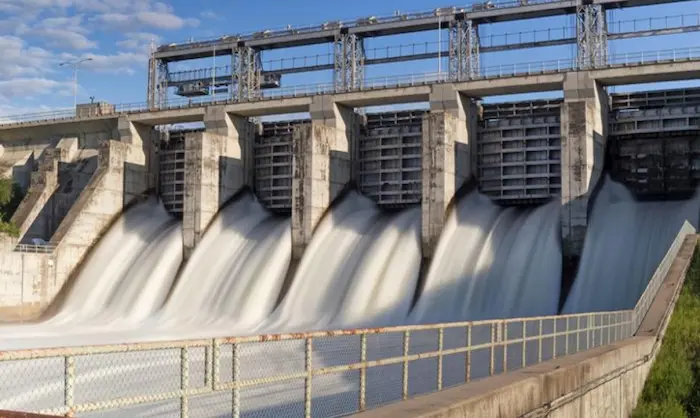
Why in News?
The water level at Pong Dam in Kangra district, Himachal Pradesh, has recently exceeded the danger mark, raising concerns about potential flooding in adjacent low-lying areas, particularly in Punjab.
Key Facts About Pong Dam
Basic Overview
- Also known as the Beas Dam
- Located in Kangra district, Himachal Pradesh
- Constructed on the Beas River
- Construction began in 1961 and was completed in 1974
Structural Features
- Type: Earth-fill embankment dam
- Height: 133 meters
- Length: 1,951 meters
- Unique feature: Constructed with a gravel shell
- Once the tallest earth-fill dam in India
Reservoir – Maharana Pratap Sagar
- Artificial reservoir formed by Pong Dam
- Named after Maharana Pratap, a historical Rajput ruler
- Designated as a Bird Sanctuary in 1983
- Recognised as a Ramsar Wetland Site in 2002
Ecological Importance
- A critical wintering ground for migratory birds
- Supports significant avifaunal diversity, including:
- Bar-headed Geese
- Red-necked Grebe
- Common Teal
- Integral part of the Himalayan wetland ecosystem
- Plays a dual role:
- Ecological conservation
- Economic utility
Utility of the Dam
- Hydropower Generation: Supplies power to the Northern Grid
- Irrigation: Supplies water to Punjab and Rajasthan through interconnected canal systems
- Flood Control: Regulates Beas River flow, especially during monsoons
- Drinking Water Source: For towns downstream
Recent Concerns
- Rising water levels due to excess monsoon rainfall
- Potential risk of downstream flooding in Punjab
- Increased focus on disaster preparedness and dam management protocols
Exam Connect – Possible Questions
Prelims
1. Pong Dam, recently in news, is constructed on which of the following rivers?
A. Ravi
B. Sutlej
C. Beas
D. Chenab
Answer: C. Beas
2. Consider the following statements about Maharana Pratap Sagar:
1. It is a man-made lake formed by Pong Dam.
2. It is located in Rajasthan.
3. It is designated as a Ramsar site.
4. It is a significant habitat for migratory birds.
Which of the statements are correct?
A. 1, 3, and 4 only
B. 2, 3, and 4 only
C. 1 and 2 only
D.1, 2, 3 and 4
Answer: A. 1, 3, and 4 only
Statement 2 is incorrect: It is located in Himachal Pradesh, not Rajasthan.
Mains
1. Discuss the dual role played by Pong Dam in economic development and biodiversity conservation. How can such structures be managed sustainably in the face of climate variability?
2. Wetlands are increasingly under threat in India. Highlight the ecological importance of Ramsar Wetland Sites with reference to Maharana Pratap Sagar.
4. US Tariffs on Indian Exports: Challenges and Opportunities for Diversification – Economy
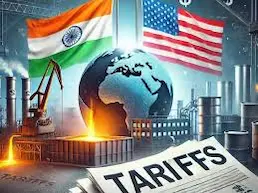
Why in News?
Effective August 27, the United States has imposed steep tariffs (up to 50%) on a range of Indian exports, particularly affecting labour-intensive sectors such as textiles, gems, and jewellery. This has sparked widespread concern in India’s export community and policymakers.
Key Takeaways
Immediate Impacts:
- 50% tariffs have made many Indian products uncompetitive in the US market.
- Export slowdowns reported in major hubs:
- Tirupur (textile hub)
- Surat (gem and jewellery hub)
- Risk of job losses and production halts in affected sectors.
Trade Dependency on the US
- 2024: The US accounts for 18% of India’s total exports
- 2010: This figure was 11%
- Increased dependence = Increased vulnerability to unilateral trade decisions.
Strategic Implications
Challenges
- Over-reliance on one trade partner limits India’s strategic autonomy.
- Labour-intensive sectors face supply chain disruptions and financial stress.
Opportunities
- Trigger for diversification of export destinations.
- Policy push to enter non-traditional markets such as:
- Africa
- Latin America
- Southeast Asia
- Encouragement of multilateral trade diplomacy and FTAs with emerging economies.
Policy Space for Reforms
Domestic Support Demanded:
- Relief package for exporters
- Support for domestic procurement to cushion demand shocks
- Enhanced logistics and trade facilitation reforms
Trade Strategy Rethink:
- Push for free trade agreements (FTAs) with alternative markets
- Boost to ‘Make in India for the World’ under Atmanirbhar Bharat
- Leveraging platforms like:
- India-MERCOSUR trade talks
- India-ASEAN FTA review
- India-Africa trade forums
Exam Connect – Possible Questions
Prelims
1. Which of the following Indian cities is primarily known for its textile export industry and has been impacted by recent US tariffs?
A. Surat
B.Tirupur
C.Ludhiana
D. Panipat
Answer: B. Tirupur
2. With reference to India’s export composition and markets, consider the following statements:
1. The United States is India’s largest export destination as of 2024.
2. The share of Indian exports to the US has decreased since 2010.
3.Gems and jewellery are among the sectors most affected by the recent US tariffs.
Which of the statements are correct?
A.1 and 2 only
B.1 and 3 only
C.2 and 3 only
D. 1, 2 and 3
Answer: B. 1 and 3 only
Statement 2 is incorrect; the share increased from 11% (2010) to 18% (2024)
Mains
1. The imposition of steep US tariffs on Indian exports reveals the vulnerabilities of overdependence on a single trade partner. Discuss how India can recalibrate its trade strategy to build long-term resilience.
2. Analyse the impact of protectionist trade policies by developed nations on developing economies like India. Suggest measures India can adopt to safeguard its export-driven sectors.
5. Punatsangchhu-II Hydroelectric Project, Bhutan – Environment
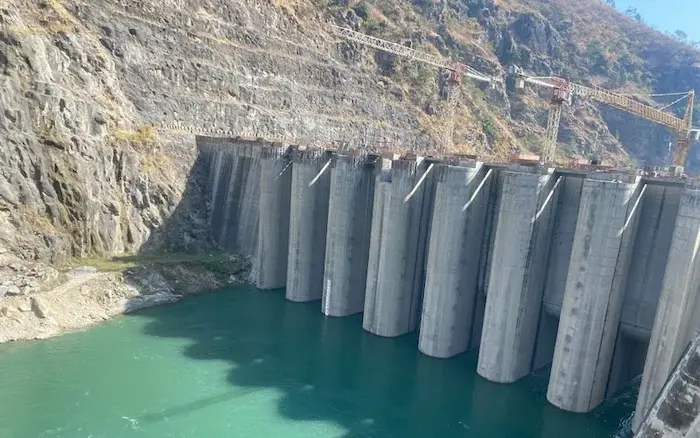
Why in News?
The Punatsangchhu-II Hydroelectric Project (1,020 MW) in Bhutan has been successfully completed, with Unit 6 (170 MW) synchronized with the national power grid, as per the Embassy of India in Thimphu.
Key Takeaways
About the Project
- Capacity: 1,020 MW (6 × 170 MW)
- Type: Run-of-the-river hydroelectric project
- Location: Right bank of the Punatsangchhu River, Wangdue Phodrang district, Bhutan
- Boosts Bhutan’s power capacity by ~40%, raising total to over 3,500 MW
Infrastructure Highlights
- Dam:
- Type: Concrete gravity dam
- Height: 91 meters, Length: 223.8 meters
- Diversion Tunnel:
- Length: 877.46 meters
- Discharge capacity: 1,118 m³/sec
- Powerhouse:
- Underground structure
- Six Francis turbines, each of 170 MW
- Operates at water head of ~236 meters
- Sluice gates: 8 meters wide × 13.2 meters high
India-Bhutan Collaboration
Inter-Government Agreement (IGA)
- Signed between:
- Royal Government of Bhutan
- Government of India
- Funding Structure:
- 30% grant
- 70% loan, with:
- 10% annual interest
- Repayable in 30 semi-annual instalments
- Repayment begins one year after commissioning
Significance for India
- Strengthens India-Bhutan energy cooperation
- Ensures clean energy imports from a friendly neighbouring country
- Reinforces India’s role as a development partner in the Himalayan region
Environmental and Strategic Significance
Environmental Aspects
- Utilizes renewable hydro energy
- Minimizes carbon emissions compared to fossil fuels
- Run-of-the-river design: Less environmental impact than large reservoir dams
Strategic Importance
- Enhances Bhutan’s energy security
- Provides revenue from electricity exports to India
- Consolidates India’s strategic presence in South Asia
Exam Connect – Possible Questions
Prelims
1. The Punatsangchhu-II Hydroelectric Project, recently in news, is located in:
A. Arunachal Pradesh
B. Nepal
C. Sikkim
D. Bhutan
Answer: D. Bhutan
2. With reference to the Punatsangchhu-II Project, consider the following statements:
1. It is a run-of-the-river hydroelectric project developed under an agreement between India and Bhutan.
2. It is funded entirely through grants by the Government of India.
3. It uses Francis turbines and has an underground powerhouse.
Which of the above statements is/are correct?
A. 1 and 2 only
B. 2 and 3 only
C. 1 and 3 only
D. 1, 2 and 3
Answer: C. 1 and 3 only
Statement 2 is incorrect: Only 30% is a grant; 70% is a loan.
Mains
1. India’s development partnership with Bhutan in hydropower reflects a model of regional cooperation in clean energy. Discuss with reference to the Punatsangchhu-II Hydroelectric Project.
2. Explain the environmental and geopolitical significance of India’s involvement in hydroelectric projects in the Himalayan region.
6. Project Aarohan: Supporting Education for Children of Toll Plaza Employees – Governance
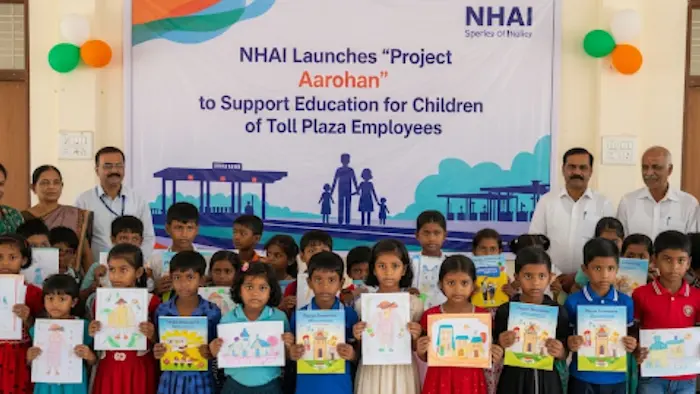
Why in News?
The National Highway Authority of India (NHAI) has recently launched Project Aarohan, a welfare initiative aimed at promoting educational equity for children of toll plaza employees, especially those from economically weaker sections.
Key Takeaways
Objective
- To support educational aspirations of children of toll plaza employees.
- Targeting:
- Economically weaker sections (EWS)
- Girls from low-income households
- First-generation learners
Implementation Details
| Feature | Description |
|---|---|
| Implementing Body | SMEC Trust’s Bharat Cares |
| Budget (Phase 1) | ₹1 crore |
| Duration | July 2025 – March 2026 |
| Beneficiaries | 500 students (Class 11 to graduation) |
| Scholarship Amount | ₹12,000 annually per student (for FY 2025–26) |
| Special Support | 50 top-performing students aiming for PG/higher education to get ₹50,000 each |
Program Components
- Financial Aid: Direct scholarship to reduce dropout risk due to financial stress.
- Mentorship: Guidance from professionals and educators.
- Skill-Building Workshops: Focus on life skills, digital literacy, soft skills.
- Career Guidance: Support for entrance exams, vocational training, and career planning.
Significance of Project Aarohan
Social Equity
- Helps bridge the socio-economic divide in access to education.
- Empowers marginalized and mobile families, often overlooked in policy frameworks.
Focus on Girls and First-Gen Learners
- Supports gender inclusion and encourages female educational participation.
- Promotes social mobility for first-generation students.
Welfare through Infrastructure Institutions
- A shift from NHAI’s core role (roads) to social responsibility, showcasing holistic governance.
Exam Connect – Possible Questions
Prelims
1. Project Aarohan, recently launched by NHAI, primarily aims to:
A. Improve toll plaza management through AI
B. Support children of toll plaza employees in accessing higher education
C. Rehabilitate displaced highway dwellers
D. Promote digital tolling infrastructure
Answer: B. Support children of toll plaza employees in accessing higher education
2. With reference to Project Aarohan, consider the following statements:
1. It is implemented by the Ministry of Education.
2. It provides scholarships to students from Class 11 onwards.
3.It includes mentorship and career guidance components.
Which of the statements are correct?
A. 1 and 2 only
B. 2 and 3 only
C. 1 and 3 only
D. 1, 2 and 3
Answer: B. 2 and 3 only
Statement 1 is incorrect: It is launched by NHAI, not the Ministry of Education.
Mains
1. Discuss the significance of Project Aarohan in promoting inclusive education for marginalized sections. How can infrastructure-based agencies contribute to social development through such initiatives?
2. Access to education remains a challenge for the children of mobile and marginalized communities. Suggest policy measures to address the socio-economic barriers faced by such groups in accessing quality education.
7. Export Promotion Mission: Boosting India’s Export Competitiveness (2025–31) – Economy
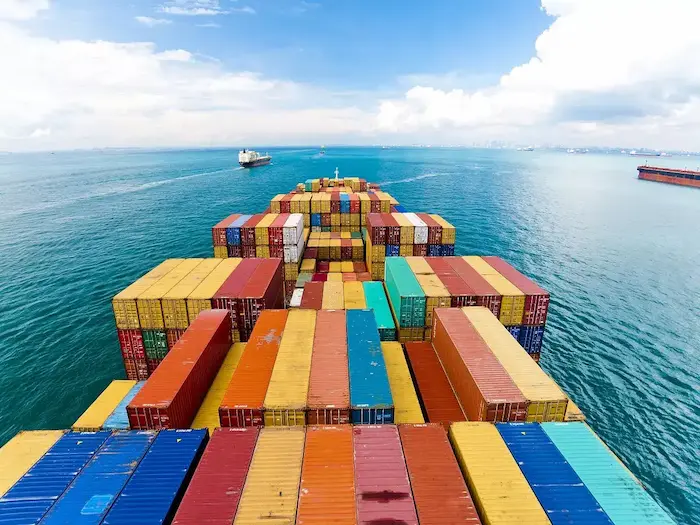
Why in News?
The Indian government is considering support measures worth ₹25,000 crore as part of the Export Promotion Mission, a major policy initiative announced in the Union Budget 2025–26. The scheme aims to enhance India’s global trade presence, with a special focus on supporting MSMEs and overcoming non-tariff and liquidity barriers.
Key Takeaways
What is the Export Promotion Mission?
A flagship policy initiative spanning six years (FY 2025–2031) aimed at:
- Accelerating broad-based, inclusive, and sustainable export growth.
- Providing targeted support to MSMEs, which face structural disadvantages in global trade.
- Addressing key issues like export credit, non-tariff barriers, and quality standards.
Implementation Framework
| Component | Details |
|---|---|
| Lead Department | Department of Commerce, Ministry of Commerce & Industry |
| Supporting Ministries | Ministries of MSME and Finance |
| Total Budget (Proposed) | ₹25,000 crore |
| Time Frame | FY 2025–31 (Six years) |
Two Sub-Schemes under the Mission
Niryat Protsahan – ₹10,000+ crore
Focus: Export credit support and easing liquidity challenges
Key Components:
- Interest equalisation support: ₹5,000+ crore over 6 years
- Alternative trade finance instruments
- E-commerce exporters’ credit card scheme
- Innovative financial solutions to reduce working capital stress for MSMEs
Niryat Disha – ₹14,500+ crore
Focus: Export ecosystem development
Proposed Components:
- Export quality compliance support – ₹4,000 crore
- Overseas market development – ₹4,000+ crore
- Export branding, warehousing, logistics
- Capacity building for MSMEs to participate in Global Value Chains (GVCs)
Significance of the Mission
For MSMEs:
- Reduces barriers to finance, compliance, and market access
- Supports first-time exporters and digital sellers
For Indian Economy:
- Enhances export competitiveness
- Reduces dependence on limited product baskets and markets
- Aligns with India’s goal to become a $1 trillion export economy
Strategic Shift:
- Moves from incentive-based export support to capability-building and compliance support
- Encourages quality, branding, and long-term market development
Exam Connect – Possible Questions
Prelims
1. With reference to the Export Promotion Mission, consider the following statements:
1. It is a five-year initiative targeting only large exporters.
2. It includes sub-schemes like Niryat Protsahan and Niryat Disha.
3. The Department of Commerce is the lead implementing agency.
Which of the statements are correct?
A.1 and 2 only
B. 2 and 3 only
C.1 and 3 only
D.1, 2 and 3
Answer: B. 2 and 3 only
Statement 1 is incorrect: It is a six-year mission and includes MSMEs
2. Under the Niryat Disha component, which of the following activities are supported?
1. Export quality compliance
2. Domestic procurement incentives
3. Overseas market development
4. Export warehousing and branding
Select the correct answer using the code below:
A. 1, 2 and 3 only
B. 2, 3 and 4 only
C.1, 3 and 4 only
D. 1, 2, 3 and 4
Answer: C. 1, 3 and 4 only
Mains
1. Discuss the significance of the Export Promotion Mission (2025–31) in making India’s exports more competitive and sustainable. How can the mission address the challenges faced by MSME exporters?
2. India’s export growth has often been constrained by issues beyond tariffs. Analyse how the new sub-schemes under the Export Promotion Mission aim to overcome non-tariff barriers and expand India’s global market reach.

